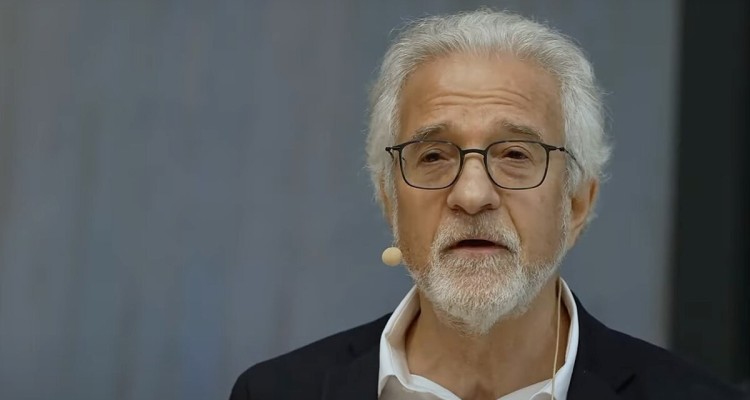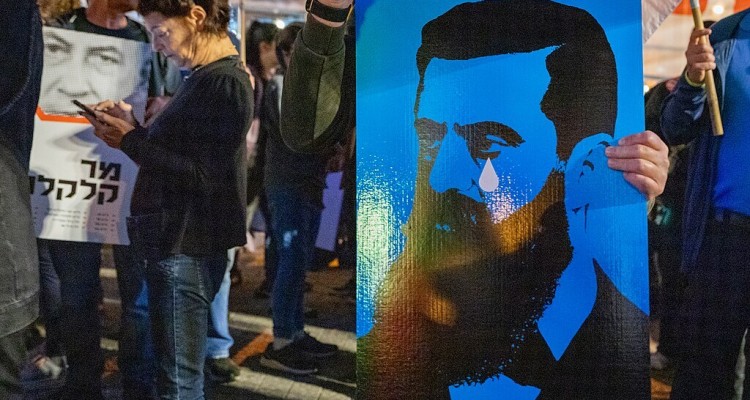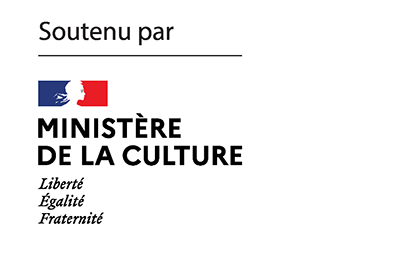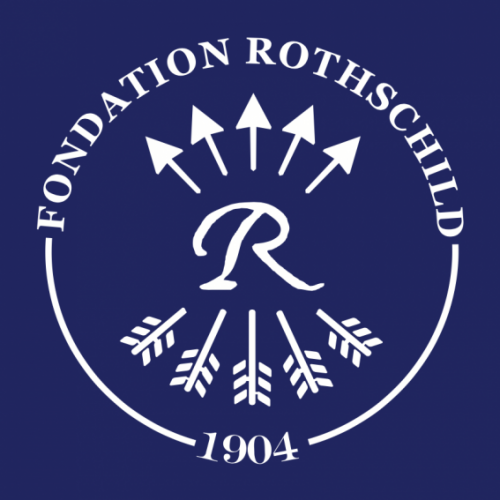In Georgia, the local Jewish community is often referred to in the past tense. And yet, this community has never experienced antisemitism. Here, Clément Girardot and Yoann Morvan reveal the story of this surprising Georgian exception, a nation whose philosemitism is not enough to ensure the continuity of its Jewish presence.
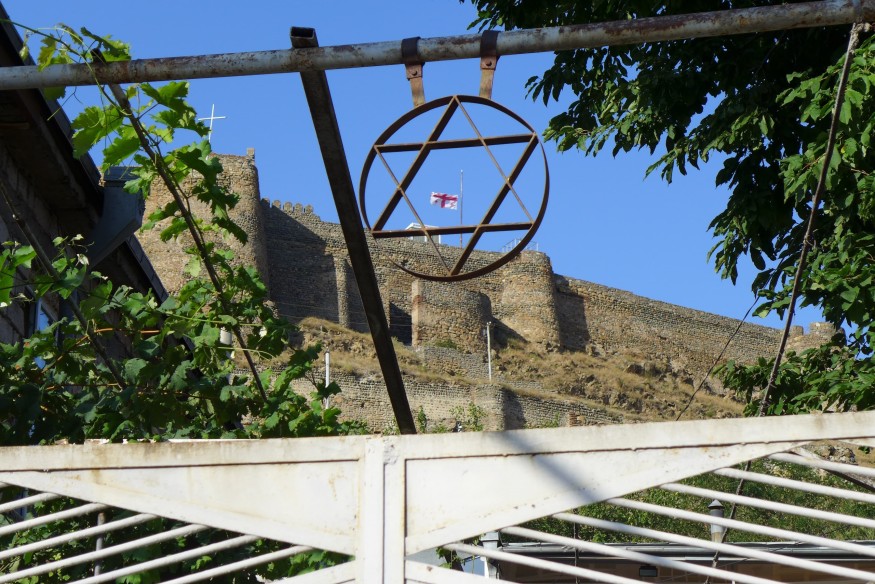
“We Georgians can be proud that there has never been any distinction in Georgia on the basis of religion. We have always fully accepted the Jewish community as an integral part of Georgia”, says Georgian President Salome Zurabishvili at the ” Friends of Zion” award ceremony in Jerusalem in January 2020. Born in Paris in 1952 into a family of exiles who had fled the Bolsheviks, Salomé Zourabichvili went on to do very well in her studies. She then embarked on a career in French diplomacy, serving as ambassador to Tbilisi before, in a rare move, leaving this position to become foreign minister (2004-2005) of her parents’ country of origin, where she was elected an MP in 2016 and then president in 2018.
Georgia is located on the eastern edge of Europe, and remains a largely unknown country in the west of the continent. The presence of Georgian populations in the Transcaucasus region can be traced back at least 3,000 years, to the foundation of the Kingdom of Colchis in the 13th century B.C. on the eastern coast of the Black Sea. An old nation cemented by a distinct language and early adherence to Christianity, Georgia has also long been a land marked by strong ethnic and religious diversity.
In her speech, Salomé Zourabichvili speaks of Georgia’s Jews in the past tense. True, the vast majority of Georgian Jews now live in Israel, with a minority in a few diaspora metropolises (St. Petersburg, Vienna, Antwerp, New York, etc.). However, a small, dynamic community, admittedly limited to a few thousand members, still lives in Georgia. It lives mainly in Tbilisi, the capital, where it is active in many sectors of social and economic life. It can rely on a number of religious and secular institutions, as well as on the proximity and flow of tourists from the Hebrew state.
In Tbilissi, home to a large Jewish community until the 1970s, it’s not unusual to come across Israeli tourists in the summer months. Some of them wear yarmulkes, and they don’t encounter any hostile reactions, if not rather a certain sympathy. Not only the political and economic elites, but also Georgian public opinion has a positive view of Jews and Israel.
Their residential areas are much more diverse than they used to be, but a few Jewish families still live in Tbilisi’s Old Town, where old houses with wide wooden balconies typical of traditional Georgian architecture can still be found. This is where the heart of local Jewish life still beats. The Georgian capital currently boasts two synagogues that are active on a daily basis, both located in the historic center between the Koura River and the Narikala fortress. This district is also home to the offices of the Jewish Agency and the Chabad movement, the Museum of the History of Georgian Jewry and three kosher restaurants.
Since independence in 1991, successive governments have all adopted favorable policies towards the Jewish community and its heritage, as well as towards Israel. Former president Mikheil Saakashvili made one of his first diplomatic trips to Israel after the Rose Revolution at the end of 2003, and made numerous public appearances at Tbilisi’s Great Synagogue. His rival, oligarch Bidzina Ivanishvili, whose “Georgian Dream” party has been in power since 2012, has contributed, via his foundation, to the renovation of numerous synagogues across the country.

Inaugurated in 1940, the building housing the Museum of the History of Georgian Jews resembles a synagogue with its imposing dome, but it has never had a religious function. The museum’s brief exhibition highlights the ancient (since the 6th century BC, according to some historical accounts) and peaceful presence of the Jewish community on Georgian soil. In the historic heart of the city, home to a large Jewish community until the 1970s, it’s not unusual to come across Israeli tourists in the summer months. Some of them wear yarmulkes, and they don’t encounter any hostile reactions, if not rather a certain sympathy. Not only the political and economic elites, but also Georgian public opinion has a positive view of Jews and Israel, a country to which a fair number of (non-Jewish) Georgian immigrants have come to work. This specific Georgian philosemitism can be explained by the strong and long-lasting socio-cultural integration of the Jewish community. Here, K. offers an unprecedented account of this symbiosis, which goes back to the very foundation of the Georgian nation.
The origins of an exceptional philosemitism
The story of the Jewish presence in Transcaucasia begins in ancient times, as did that of the first Georgian kingdoms. According to some historians, their settlement dates back to the 6th century BC, although there are several contradictory accounts. “Historical tradition rather supports the version of the “Life of Kartlie” (by chronicler Leonti Mroveli, 11th c., ed.) according to which the first wave of Jews, provoked by Nebuchadnezzar’s invasion of Jerusalem, had reached Kartlie[1] in 586 BC,” wrote Georgian Jewish intellectual and politician Jemal Ajiashvili (1944-2013). Archaeological evidence attests to the existence in the first centuries AD of a Jewish community in the city of Mtskheta, then capital of the Kingdom of Iberia[2].
From this history emerges a crucial fact: in Georgia, the Jews are considered to have contributed to bringing Christianity to the developing nation. The monograph “The History of Georgian Jews“, written by Eldar Mamistvalishvili (2014), refers to numerous sources indicating that, during the early Christian era, members of the local Jewish community would have converted and spread the word of Christ to pagan Georgians.
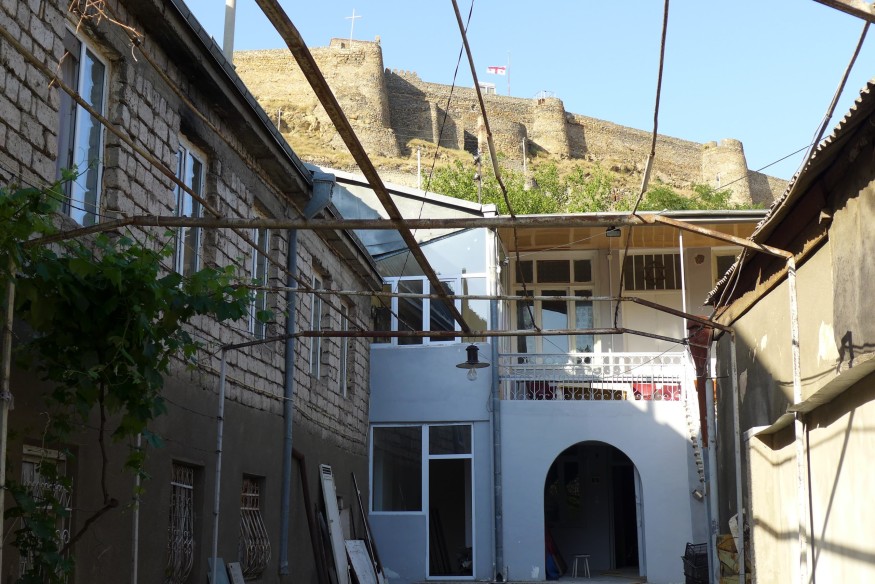
During the Golden Age of the Kingdom of Georgia in the 12th century, Jews were present in the ruler’s court. According to some legends, it was a Jewish merchant who was sent to Russia to find a husband for Tamar, a woman who held the title of “king” and ruled the country from 1184 to 1213. Another legend attributes Jewish roots to the royal Georgian Bagrationi dynasty, in filiation with King David; a legend much disputed by historians, but a way of proving the biblical character of the Georgian “people”.
Although the following centuries were marked by multiple Arab, Mongol, Turkish and Persian invasions, a Georgian identity, both plural and distinct, nevertheless managed to endure over the centuries. The Jews largely adopted Georgian socio-cultural characteristics, such as the codified art of banqueting (‘supra‘ in Georgian) and the practice of viniculture[3] while preserving their religious identity. The community also diversified due to Georgia’s position as a crossroads between East and West.
“Interactions with other territories were numerous, as Jews were engaged in trade (a role that was clearly reinforced following the abolition of serfdom in the Russian Empire in 1861, AN). Over the course of history, sub-groups settled in Georgia, such as mountain Jews[4], Iranian Jews and Ashkenazim, while Georgian Jews have also settled elsewhere, such as in Constantinople,” asserts Temur Yakobashvili, an influential member of the Georgian Jewish community who has held the posts of Minister for Reintegration (2008-2010) and Ambassador to the USA (2010-2013), a country where he still lives since the end of Mikheil Saakashvili’s presidency (2004-2013).
Jews are the only non-Georgian social group to be referred to as “Georgian”, which is not the case for the main ethnic minorities: Armenians, Azeris, Ossetians and Abkhazians. Unlike the latter, Georgian Jews have adopted Georgian surnames with a -chvili ending.
During the long feudal period, a large part of the Jewish population was concentrated in rural towns, the best known of which are Kulashi, Vani and Lailashi in the west, and Surami, Kareli, Gori and Tskhinvali further east[5]. These latter towns are located in one of the agricultural foothills of the central region of the Greater Caucasus (which culminates a little further north at Mount Kazbek at 5054 m). Many Jews were reduced to servitude by Christian lords, but some historical sources also mention the existence of Jews who were able to own property and who included Christian serfs among their domestic servants (a situation that was certainly rare, but unthinkable in Western medieval Europe).
“During the feudal period, which lasted in Georgia until the beginning of the 19th century, a large proportion of Jews were active in agriculture, and many also in trade and financial operations”, writes geographer Revaz Gachechiladze[6]. Most Jews engaged in commercial activities were itinerant merchants who moved from village to village. Georgian Jews therefore lived on the fringes of the rural world, and relatively few were involved in large-scale trade, which was dominated by Armenians, except in Akhaltsikhe, on the edge of the Ottoman Empire and a hub of international trade. The fortress, hastily renovated in 2011-2012 with Turkish funding, bears witness to the city’s importance and multicultural character, with a mosque and a church in its midst[7]. It overlooks the old town and its two synagogues, where a Jewish community[8] counted up to more than 3,000 people.
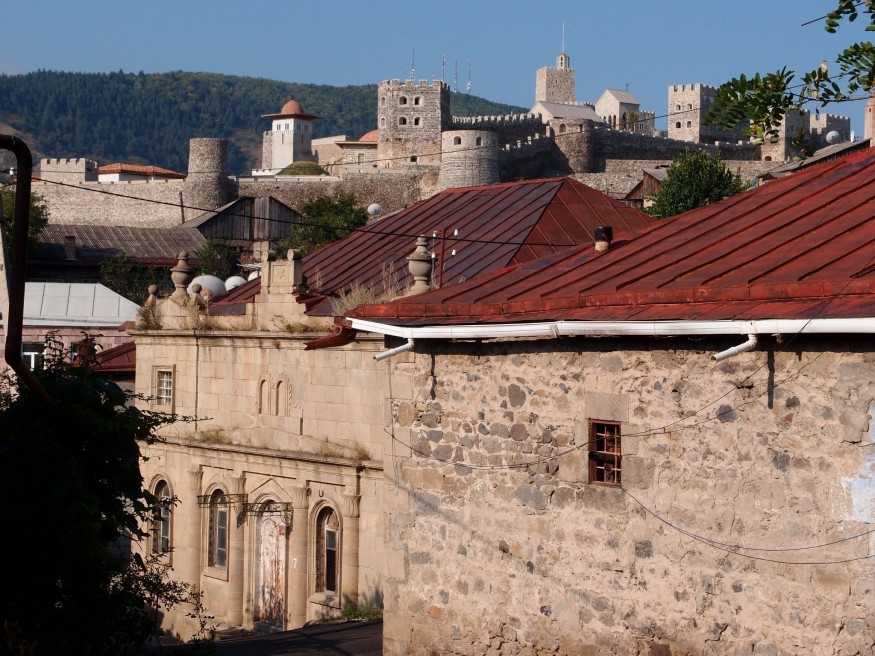
Tossed between the great empires and divided between its various provinces, Georgia lost its territorial unity from the 16th century onwards. The evolution of Georgia’s Jewish community has also been marked by waves of foreign invasions and territorial divisions that have weakened it. But it has also been able to take advantage of its strategic location at the crossroads of important trade routes, whether under the influence of the rival Ottoman and Persian powers (16th-18th centuries) or later during its integration into the Russian Empire (1801-1918).
The latter involved a protectorate treaty between the Kingdom of Kartlie-Kakhetia and Russia in 1783. Importantly for contemporary Georgian historiography, however, Russia failed to fulfill its obligations, allowing the Shah of Iran to conquer and raze Tbilisi in 1795, then annexing Kartlie-Kakhetia in 1801, before subjugating or vassalizing the country’s western territories.
The Russian annexation and conquest of the whole of Transcaucasia also led to an influx of Ashkenazi Jews, particularly in Tbilisi, where a Yiddish-language cultural life and educational institutions developed, traces of which have now all but disappeared[9]. To mark a distinction with “Russian Jews”, it was then that the expression ქართველი ებრაელები (kartveli ebraelebi) became popular in intellectual debate and within the community, which can be translated as “Georgian Jews[10]”. The two elements are considered to be grammatically indissociable, testifying to the centuries-old symbiosis between the Jews and the Georgian people. Above all, Jews are the only non-Georgian social group to be referred to in this way, unlike the main ethnic minorities: Armenians, Azeris, Ossetians and Abkhazians. Unlike the latter, Georgian Jews have adopted Georgian surnames with a -shvili ending[11] (sons of) such as: Davitashvili, Eliashvili, Leviachvili, Abramiachvili… In his monograph, Eldar Mamitsvalishvili lists 189 surnames that are “largely borne by both Jews and Georgians”.
A singular place in the Russian Empire and the USSR
The abolition of serfdom in the Russian Empire in 1861 put an end to a long period of feudalism. This major date marked the advent of modern political communities and increased urbanization. Many Jews became shopkeepers and moved away from more rural localities. Against a backdrop of local philosemitism, there was no movement to assert emancipation claims specific to Georgia’s Jewish community.
In the writings of Georgian intellectuals with nationalist aspirations, the spread of the expression “Georgian Jew” confirmed that Jews belonged to a religiously diverse Georgian nation, whereas in many Eastern European societies, the affirmation of a national sentiment tended to exclude Jewish communities.
For their part, Jews took contrasting positions regarding their place in the process of national construction that led to the establishment of the short-lived First Republic of Georgia (1918-1921). “Assimilationists” shared the theses of nationalist intellectuals, who saw the history of the Jewish people as an example of a “proud” and independent people. They strongly distinguish Georgian Jews from recent Ashkenazi immigrants.
Exceptionally, Georgia, despite its various imperial integrations, has guaranteed Jews a stability of status enabling the permanence and continuity of their presence.
But there are two other groups that enjoy greater support among the various local Jewish populations: Orthodox Jews, who are above all keen on preserving the traditional religious life of Georgian Jews within a Georgian homeland shared with Christian Georgians; and Zionists, who support the idea of Georgian Jews and Ashkenazim belonging to the same nation, a Jewish nation distinct from the Georgian nation. In addition to these groups, the Chabad movement appeared in Kutaisi from 1916 onwards, as historian Gershon Ben-Oren recounts in In the Land of Golden Fleece (1992), a movement with a promising future among Georgian Jews.
Although acts of antisemitic violence were documented in the 19th and 20th centuries, they remained isolated phenomena and did not alter the good relations between Christians and Jews. “While European and Russian Jews were direct subjects of the state, perceived as a ‘nation within the nation’, Georgian Jews found in Georgia the intermediate and protective space of a homeland,” argue historians Nino Chikovani and Ketevan Kakitelashvili of Tbilisi State University, as well as philologist Nino Pirtskhalava of Tbilisi-based Ilia State University in an academic article[12].
Exceptionally, Georgia, despite its various imperial integrations, has guaranteed Jews a stability of status enabling the permanence and continuity of their presence. “Georgia was integrated into the Persian, Ottoman and Russian empires. The policy of each entity towards the Jews should have applied there, but this was not the case, and this also applies to the Soviet period”, Temur Iakobashvili points out to K.. “For example, Georgian Jews were not affected by the discriminatory laws of the Russian Empire[13] and this can probably be explained by the 26 centuries of coexistence and cohabitation.”
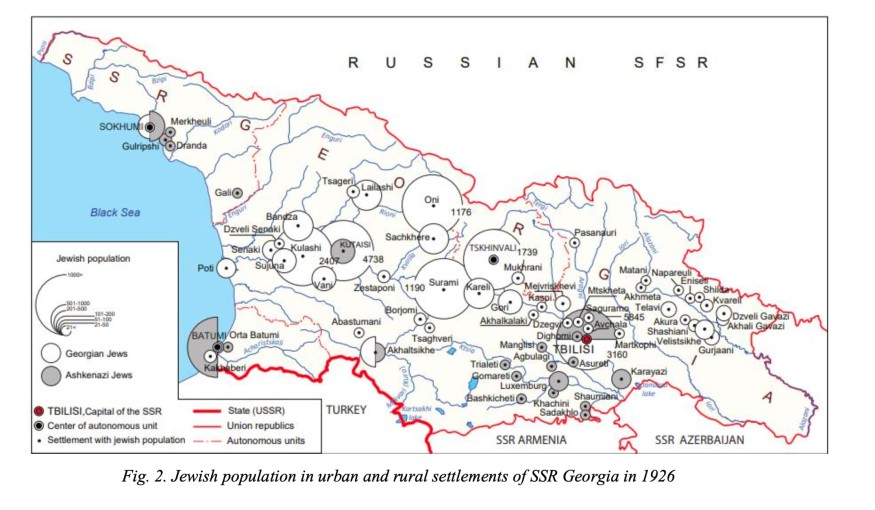
During the Soviet period, which began in Georgia with the Bolshevik invasion of 1921, Jews were considered a separate nationality under the nationalities policy and enjoyed – theoretically – equal rights with other citizens under the constitution. Yet the Soviet regime, combining old Russian antisemitism with communist hostility to religions and Western imperialism, has a long history of coercion and discrimination against the Jewish communities present on its territory.
In the 1920s and 1930s, the first upheaval was geopolitical, with the establishment of the Iron Curtain, which materialized in the Caucasus with the closure of the border with Turkey[14] and blocked international mobility until the 1970s. Interactions were almost exclusively directed towards the north and Russia’s major urban centers. Many members of the Jewish community played a key role in the so-called “second economy”, the non-state sector that more or less legally made up for the shortcomings of the planned economy. Nevertheless, the collectivization of enterprises and the nationalization of the economy, oriented towards the industrial and agricultural sectors, posed major difficulties for a population that had largely turned to commercial activities.
Demographic changes are also significant. According to official censuses, the Jewish population of Georgia rose from 33,000 in 1926 to 55,000 in 1970[15]. A strong migration of Georgian Jews to the metropolises reinforced the role of Tbilisi, a city historically less important than Kutaisi, and predominantly populated by Ashkenazim at the beginning of the 20th century.
As the Cold War began, the Soviet regime viewed synagogues as an instrument of political pressure used by the West. Observant Jews were seen as disloyal citizens who used their synagogues as channels of communication with Moscow’s enemies,” notes historian Leonid Smilovitski.
After the Second World War, the USSR stepped up its antisemitic policies, intensifying the persecution of Jewish communities and their religious and educational institutions. “As the Cold War began, the Soviet regime viewed synagogues as an instrument of political pressure used by the West. Observant Jews were seen as disloyal citizens who used their synagogues as channels of communication with Moscow’s enemies”, notes historian Leonid Smilovitski in an article published in 2008 by Cahiers du Monde Russe.
In Georgia, as with churches, many synagogues were desecrated and used as warehouses or clubs. In 1952, the Soviet authorities attempted to close down all the synagogues in the town of Kutaisi, prompting a revolt by the local community. The day workmen arrived to transform the main synagogue into a club for the communist youth organization (Komsomol), hundreds of Jews gathered and lay down on the road to prevent the trucks from passing. The local authorities backed down.
This event is recounted in a travelogue by the Israeli Ben Ami, who came semi-clandestinely to meet the Jewish communities of the USSR in the 1960s[16]. It illustrates the persistence of the Georgian exception despite oppression. According to the author, religious freedom and practice were greater in Georgia than elsewhere in the Soviet empire.
“Jews hid to pray, but the situation was not comparable with Russia. In Gori, life was easy, we had a rabbi. But as we didn’t have access to a Jewish education, community life became more secular in the 70s and 80s,” recalls Arno Janashvili, who grew up in the small town, Stalin’s hometown. He now lives with his family in Tbilisi, where, among other things, he produces and sells kosher alcohol. Today, the Gori community is reduced to around forty members, and remains one of the few active outside Tbilisi.
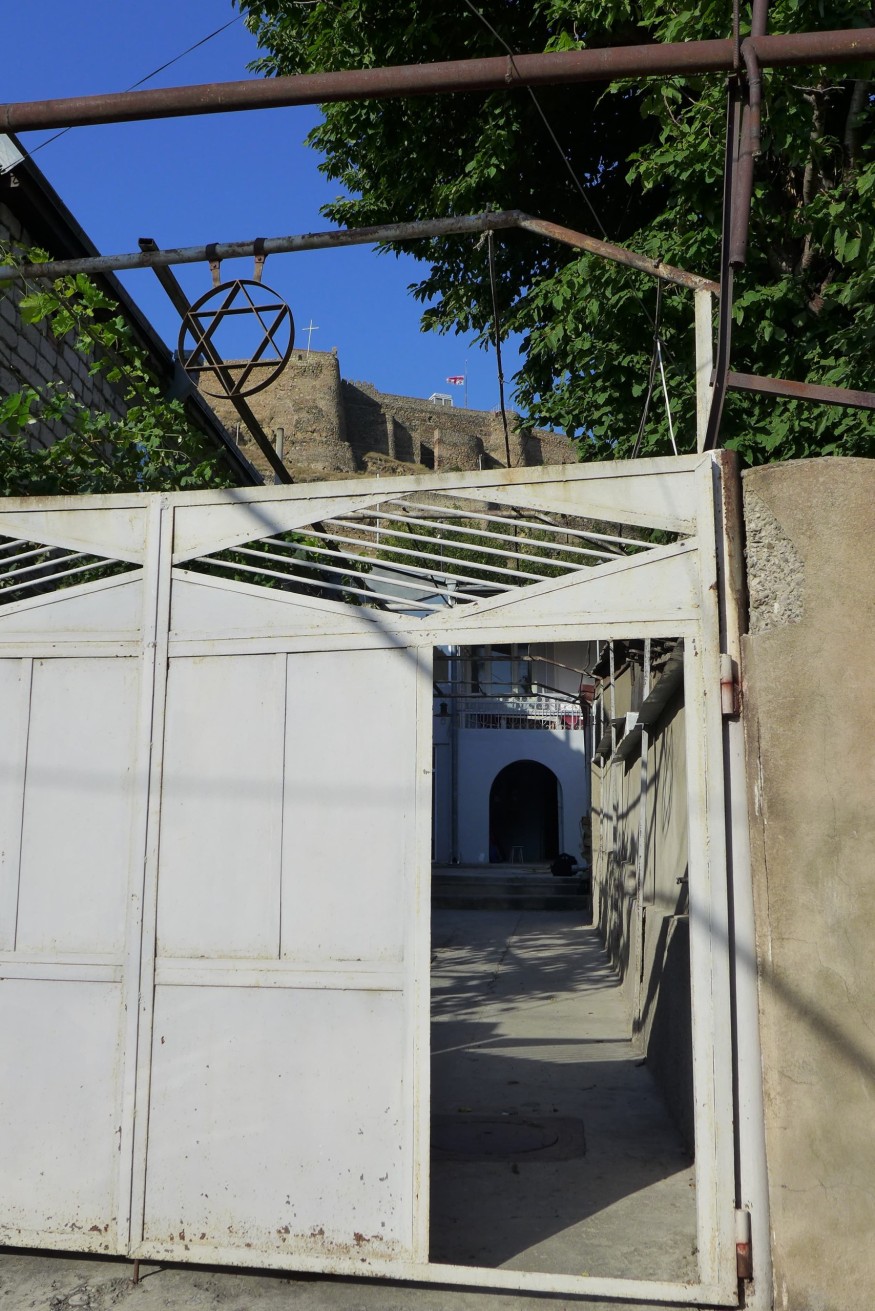
For the majority of Georgian Jews, who have remained observant, a stronger religious life persists in the family sphere, a refuge from the difficulties of expressing their faith in existing synagogues and in the public arena. “There are usually three generations of the same blood in the household. It’s quite common to see ten to twenty people gathered around a table, which is very rare among Ashkenazi Jews (…). On Sundays and holidays, the whole family gathers at the grandfather’s house,” Ben Ami describes in his book.
After the great exodus, the dilemma of Georgian Jews
Since its foundation, the Zionist movement has had many supporters in Georgia, even though it is opposed by Orthodox and Chabad-affiliated rabbis. The migration dynamic began at the end of the 19th century. As early as the 1920s, a small group of a few dozen families living in the old town of Tbilisi managed to obtain permission to migrate to Palestine before Zionist activities were totally banned in the USSR. Georgian Zionism has different accents to that which circulates in other Jewish cultural and political spaces. It was a more religious Zionism, and rather less political than in the Ashkenazi world.
It wasn’t until the 1970s that the migration of Georgian Jews to Palestine, where the State of Israel had meanwhile been founded, was resumed and then extended to all Jewish communities in the USSR.

“The prophecy has come true: Israel is rising from the ashes. We have not forgotten Jerusalem, and it needs our hands,” wrote 18 Jewish families from Tbilisi in a letter they secretly addressed in 1969 to Israeli Prime Minister Golda Meir and the United Nations. The lengthy letter made extensive reference to the Zionist dream of return and denounced the administrative difficulties encountered by Soviet candidates for emigration to Israel.
The 1969 letter contradicts Soviet propaganda claiming that its Jewish population is losing interest in Israel. It is a historic document, since it constitutes the first public appeal by Soviet Jews for the right of return[17]. This text, written in an elaborate Russian, had strong repercussions both in Israel and internationally.
“It is arguably one of the most defining moments in the history of European Jewry over the past half-century,” writes American researcher Izabelle Tabarovsky in the online magazine Tablet. “The letter inspired Jewish activists elsewhere in the Soviet Union. (…) It prompted the Israeli government to radically alter its policy, after supporting it clandestinely, Soviet Jewish emigration becomes a public cause. And it paved the way for the definitive exodus of 1.5 million Soviet Jews from the USSR.” Between 1970 and 1988, almost 300,000 Jews left the USSR[18].
Georgian Zionism has different accents to that which circulates in other Jewish cultural and political spaces. It’s a more religious Zionism, and rather less political than in the Ashkenazi world.
According to official figures, the number of Jews in Georgia fell from 55,000 in 1970, including 45,000 Georgian Jews, to 28,300 in 1979 and 24,800 in 1989, marking a slowdown in emigration during the 1980s. Georgia lost 60% of its Jewish population and Tbilisi 42%. 10% of departures were to countries other than Israel, notably Vienna, the hub of East-West migration and trade during the Cold War.
In the years leading up to the dissolution of the USSR, as Mikhail Gorbachev embarked on a process of reform with perestroika and glasnost, a Jewish cultural revival was perceptible throughout the Union, particularly in Tbilisi. In November 1989, the Caucasian metropolis hosted the founding congress of the Soviet Jewish Students’ Union.
“Representatives came from 46 cities across the USSR. It was historic, because it wasn’t 100% legal to have a conference dedicated to Jewish issues”, recalls Itsik Moshe, then in his sixties, emissary of the World Union of Jewish Students, who came specially from Israel for the occasion. This man of influence, born in Georgia but raised in the Hebrew State, currently heads the Israeli-Georgian Chamber of Commerce and the NGO Israeli House.

Shortly after this conference, he returned to Tbilisi as a representative of the Jewish Agency, which established its first office in the Soviet Union in the Caucasian metropolis: “It was a major challenge to get into the USSR, it was incredible because diplomatic relations with Israel were non-existent,” continues Itsik Moshe.
During the last years of the Soviet Union and the post-Soviet period that began in 1991, a migration movement even more massive than that of the 70s began throughout Eastern Europe and Central Asia, less for ideological reasons than because of the rapid deterioration in living conditions. The departures concerned Jews as much as the rest of the population.
In all sectors of Georgian society, families chose exile to escape the deep economic recession of the 90s, as well as security problems linked to the reign of mafia gangs and separatist conflicts with the provinces of Abkhazia and South Ossetia.
In the early 2000s, following the Rose Revolution and the election of pro-Western reformer Mikheïl Saakachvili in 2004, the country stabilized and returned to the path of economic and social development. But by then, the Jewish community had all but disappeared. Between 2002 and 2014, the number of people answering “Jewish” regarding religious affiliation in the national census fell from 3,700 to 1,400.
A peaceful political changeover took place in 2012 when the “Georgian Dream” came to power, a catch-all formation led by the oligarch Bidzani Ivanishvili, who built his fortune in Russia. Initially pursuing Saakashvili’s pro-European policy, the new government negotiated an association agreement with the European Union, signed in 2014, but over time adopted increasingly conciliatory positions with Moscow, particularly since the outbreak of the Ukrainian conflict. Symbolizing the regime’s pro-Russian turn, at the end of May the government had parliament definitively adopt a law on “foreign agents” concerning the funding of NGOs. Strongly inspired by Russian regulations hostile to civil society, this law prompted a massive mobilization of Georgians in the streets and the unanimous condemnation of Western “partners”.
‘We believe that the diaspora should no longer exist. It’s true that Georgia has a beautiful history devoid of antisemitism, but that’s over! It’s better to live in Israel.’
Following the steady decline of the Jewish community in the 90s and 2000s, Georgia’s Jews face a double dilemma. First, to stay or to leave? Then, to keep the community alive or safeguard the country’s immense and little-known Jewish heritage, which illustrates a multi-millennial philosemitism?
For Zionists like Itsik Moshe, the debate is clear-cut: “We believe that the diaspora should no longer exist. It’s true that Georgia has a beautiful history devoid of antisemitism, but that’s over! It’s better to live in Israel.
In the context of his activities with the Chamber of Commerce or the NGO Israeli House, he has relatively few links with the Georgian Jewish community still present in Tbilisi. Founded in 2013, Israeli House focuses on cultural cooperation: “We don’t work to preserve Georgian Jewish culture, but to safeguard heritage, which forms a basis for good relations between Georgia, Israel and the Jewish world.”
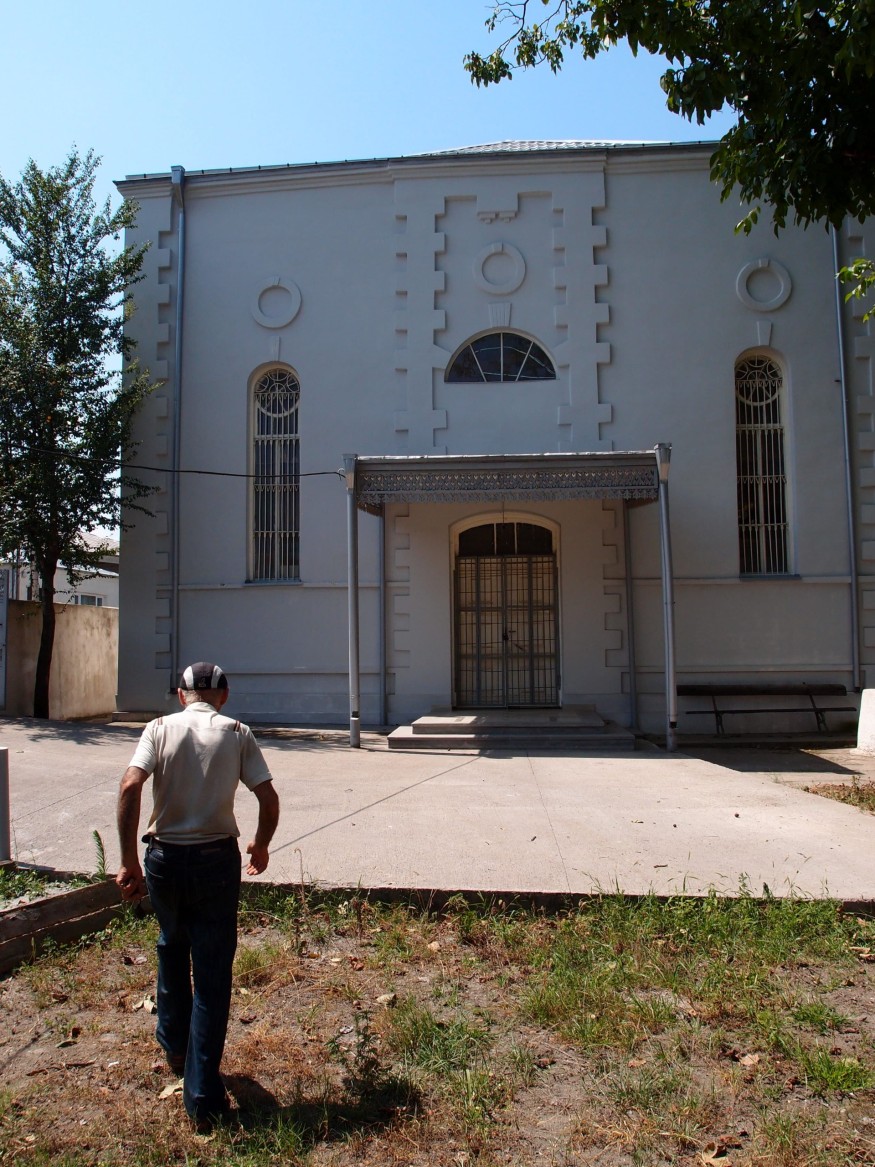
This heritage, largely made up of disused cemeteries and synagogues, is located mainly along the East-West ridge linking Tbilisi to the Black Sea, recalling the geographical distribution of the Georgian Jewish population in pre-modern times, marked by the importance of peddling activities. As part of the “European Jewish Heritage Routes” program supported by the Council of Europe, Israeli House has designed a Georgian itinerary comprising some forty sites scattered throughout the country[19], relying on the many renovated synagogues along this East-West axis[20].
Away from this axis, in the mountainous region of Racha in north-west Georgia, the magnificent Oni synagogue, a veritable architectural gem built in 1895, has become a local landmark and attracts a few tourists to this once religiously active Jewish hotbed. “During my youth, several hundred Jewish families lived in Oni. Today, there are only 12 people left,” says Mikheil Khananashvili, a native of Oni in his late forties and now a Shochet in Tbilisi.
In contrast to the work of Israeli House, the youth organization Hillel attempts to combine heritage awareness with the revitalization of Jewish life in Georgia. “A grant from the Dutch Jewish Humanitarian Fund enables us to take young people to visit places where Jews lived and formed significant communities until the 1990s. 95% of the students have never visited these places,” says Keti Chikviladze, coordinator[21] for 10 years in Tbilisi from this international network with a strong presence in Eastern European countries. Included in the program of excursions: Akhaltsikhe, Surami and Oni.
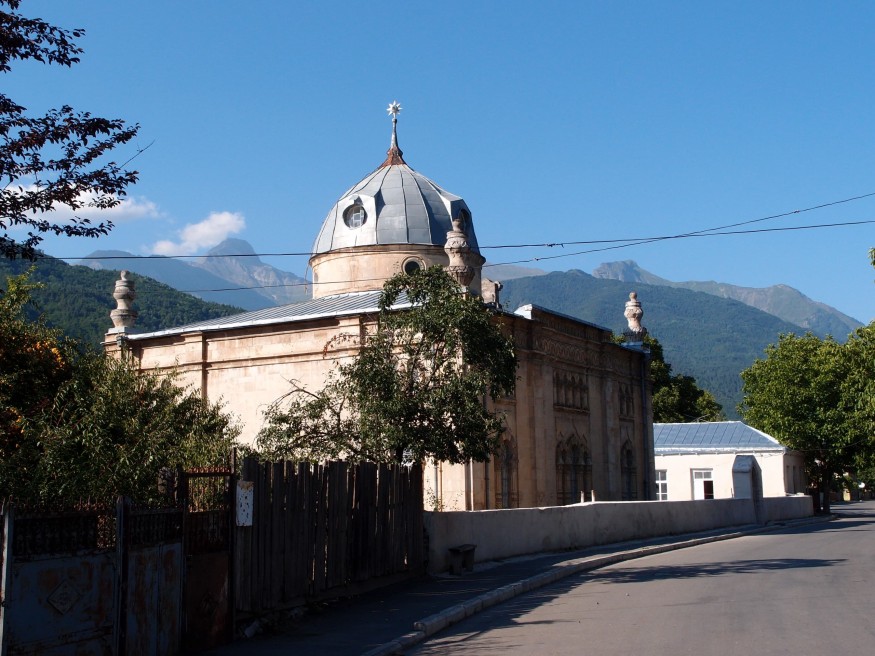
Between 50 and 80 young people regularly take part in Hillel’s activities. They either come from mixed families or have recently rediscovered their Jewish roots, mainly Ashkenazi. Keti Chikviladze, whose grandmother is Ashkenazi and whose grandmother comes from the “Mountain Jews” community in the North Caucasus, also only reclaimed her Jewish identity as a teenager following a trip to Israel.
She hopes that Hillel’s actions will revitalize the local Jewish community: “Some people within our community are pessimistic. For our part, we’re trying to get young people involved, because we want to preserve Jewish life in Georgia. Otherwise, it will be over in a generation”.
Clément Girardot and Yoann Morvan
Notes
| 1 | Central region of Georgia. |
| 2 | During antiquity, Iberia covered the eastern part of present-day Georgia and Colchis the western part. |
| 3 | Ben Ami reports in his book Between Hammer and Sickle (1968) that Georgia’s Jewish community has been involved in vine cultivation and the wine trade since antiquity. |
| 4 | A group also known as ‘Juhuro‘, originally from Persia, who then settled mainly in the east and north of the Caucasus, particularly between Dagestan and Azerbaijan. |
| 5 | Formerly a major center of Jewish life in Georgia, since 1992 it has been the capital of the self-proclaimed, Russian-backed Republic of South Ossetia. There is currently no Jewish community in Tskhinvali, unlike in neighboring Gori. |
| 6 | Source: Revaz Gachechiladze. (2021). A historical geography of Jewish settlement in Georgia (The Caucasus). Georgian geographical journal, 1. |
| 7 | On this subject: “Sharing the Not-Sacred: Rabati and the Display of Multiculturalism”, Silvia Serrano in Darieva T, Mülfried F., Tuite K. Sacred Places, Emerging Spaces. Pilgrims, Saints and Scholars in the Caucasus, Berghahn, 2018, pp. 203-225. |
| 8 | Interesting video report on a member of Akhaltsikhe’s Jewish community who painted scenes of daily life in the 19th century: https://special-projects.chaikhana.media/The-Legacy-of-Jewish-Communities/story1.html. |
| 9 | Two Yiddish-language schools and publications remain. A Yiddish-language theater group has just been re-established this year – there was one at the beginning of the 20th century. For some years now, Yiddish has also been taught in the Department of Jewish Studies at Tbilisi’s Ivane Javakhishvili State University. |
| 10 | During the medieval period, the terms “ebraeli” (without kartveli) and “uria” were most commonly used. The etymology of uria is subject to debate and is thought to be linked to the toponym Ur: either a city in the Caucasus whose traces have disappeared, or the biblical “Ur of the Chaldees” now located in Iraq. |
| 11 | For our text, we have chosen to adopt the international -shvili spelling except for well-known surnames |
| 12 | Jewish identity in Georgia in light of the European cultural-political tradition at the turn of the twentieth century, Frankfurter Judaistische Beiträge 42 (2018) 89-128. |
| 13 | Adopted in 1881, the May Laws forbade Jews to live wherever they wished (Jewish populations had already been forced to live within the limits of the “residence zone”, which included the western territories of the Empire, since 1791), set restrictive quotas for Jewish access to education and certain professions. In parallel with this antisemitic policy, pogroms multiplied on the territory of the Russian Empire. |
| 14 | Cross-border mobility, initially permitted in the 1920s, was severely restricted during the Stalinist period (1924-1953), particularly in the 1930s, following the introduction of passports and the creation of a “forbidden border zone” along the Turkish border, designed to prevent smuggling and the entry of subversive elements, as well as any attempt at emigration. |
| 15 | Source: Revaz Gachechiladze. (2021). A historical geography of Jewish settlement in Georgia (The Caucasus). Georgian geographical journal, 1 (1). |
| 16 | Ben Ami, Between Hammer and Sickle, 1968. |
| 17 | Christian Jelen and Léopold Unger recount in detail this mobilization and its scope in the book Le grand retour, Albin Michel, 1977. |
| 18 | Source: https://daviscenter.fas.harvard.edu/events/half-century-jewish-emigration-former-soviet-union-demographic-aspects#:~:text=Based%20on%20collected%20data%2C%20it,of%20about%20half%20a%20century |
| 19 | The itinerary also includes synagogues in the towns of Sukhumi in Abkhazia and Tskhinvali in South Ossetia, two provinces that seceded from Georgia in the 1990s with Moscow’s support, and which are not easily accessible to foreign tourists. |
| 20 | Except for Kutaisi, they are located in villages where there are usually only one or two Jewish inhabitants, most of them elderly (and with few resources). |
| 21 | Keti Chikviladze left Hillel in September 2023, following disputes over the organization of an inclusive, ecumenical Jewish religious ceremony in Tbilisi. |

